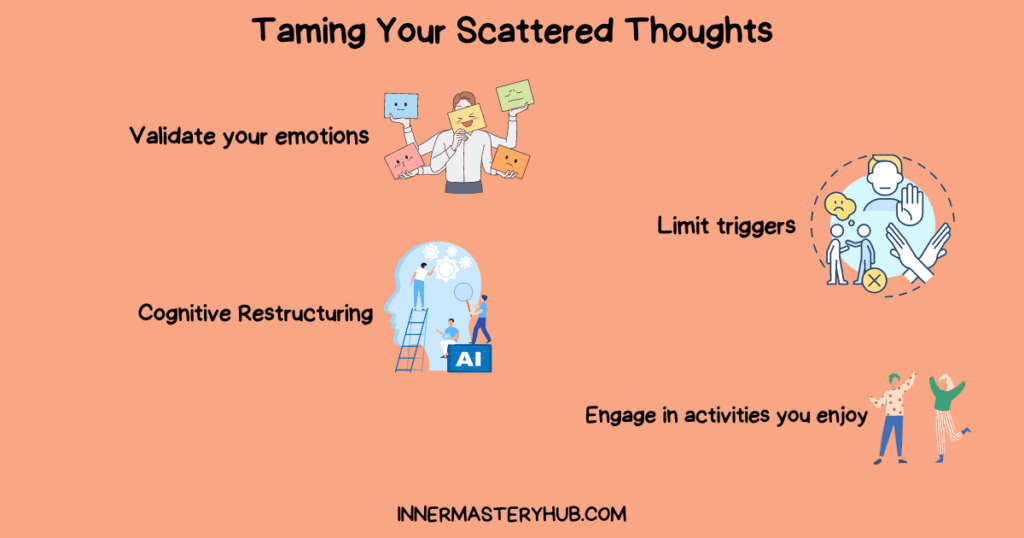Overcome Negativity by Reframing Your Thoughts in 6 Steps

We are frequently caught in an endless cycle of self-doubt and hopelessness, driven by negative thinking. From interpersonal connections to professional pursuits, this mental habit can affect every aspect of our lives and significantly reduce overall satisfaction and wellbeing.
Compared to their more optimistic peers, those who battle with negative thought patterns may be more likely to feel anxiety, stress, and sadness. According to National Science Foundation research, up to 80% of an individual’s daily 12,000 thoughts may be negative. This illustrates a typical difficulty that many people have in controlling their mental state.
Let’s find out the steps to reframing your thoughts.
Reframing negative thoughts Download here.
The Impact of Negative Thinking
Constantly thinking negatively can have profound long-term implications on your mental and physical health, in addition to ruining your day.
According to studies like those in the Journal of Clinical Psychology, negativity is associated with a weakened immune system, worse cardiovascular health, and a decreased capacity for pain. Furthermore, having a negative mindset at work might decrease involvement and productivity.
A negative outlook can distort reality, darkening your experiences and ambitions and making obstacles seem impossible.
What does it mean to reframe your thoughts?
Reframing your thoughts is like viewing the same image through a new frame. To feel better about things, you need to shift your perspective. Initially, you identify the thoughts that bring you down. These could include ideas such as “I can never do anything right.” Then you question these ideas. Think about it: “Is this true?”?
“What would I tell a friend who thought this?” The negative is then replaced with something more realistic and positive, such as “Everyone makes mistakes, but I can learn from mine.” You can view things differently and manage life’s ups and downs a little better as a result. It’s a valuable tool, particularly in times of feeling depressed or trapped.
The Power of Reframing Your Thoughts
Identify and Acknowledge
The first step to change is to be aware of and recognize negative thoughts when they occur. You can pause and critically evaluate the impact and veracity of these thoughts because you are self-aware. For example, stop and consider whether you’re right when you think, “I’ll never be good at this.” Does it accurately reflect your anxieties, or is it a heightened version of them?
Examine and replace
Once a flawed notion has been recognized, question its veracity. Take its place with a more realistic, well-rounded idea that better captures reality.
For example, changing your attitude from “I’ll never be good at this” to “I am improving with every attempt” moves you toward a growth mindset, which is crucial for success and personal development, according to a study by psychologist Carol Dweck.
Question the thought’s accuracy.
Questioning the accuracy of your thoughts is a crucial step in cognitive reframing, especially when dealing with negative thought patterns. The procedure involves analyzing your thoughts to see if biases or exaggerated worries influence them, or if they truly reflect reality. To refute the notion that “I always fail,”
For example, you can ask yourself, “Is it truly always? Have I not accomplished many duties in the past? By remembering certain success stories, you can see that the idea isn’t accurate. By replacing false, pessimistic thoughts with more realistic, balanced ones, this technique improves your emotional health and decision-making.
Show gratitude and mindfulness.
By practicing mindfulness, you may stay engaged and present, reducing your likelihood of drifting into negativity. Deep breathing, meditation, and spending time in nature are among the techniques that might help you de-stress and clear your head.
Additionally, expressing gratitude is a fantastic method to effect constructive change. Keeping a gratitude journal and recording your blessings every day may help you shift your focus from the negative to the positive.
Cognitive reframing
Cognitive reframing gives you a fresh perspective. If you typically think negatively, for example, “I never do anything right,” you may shift to something more balanced, such as “I sometimes make mistakes, but I also succeed often.”
This method helps you pinpoint both your strengths and areas for improvement, rather than concentrating just on your weaknesses. You start to see challenges as opportunities to improve your abilities when you change your mindset from “If I make a mistake at work, I’ll be fired” to “Everyone makes mistakes, and I can learn from them.”
This technique helps you better manage your emotions by taking a more optimistic or neutral view of the situation.
Please write it down.
Putting your thoughts in writing might help you manage them, especially if they are bothering you. When you write out a concept like “I always fail,” it’s in the open and easier to see. You can then examine it closely and ask yourself, “Is this true?”
Usually, there is proof to the contrary of these categorical claims. For instance, you can see that “always” is an exaggeration by thinking back on particular accomplishments. Writing allows you to externalize your ideas, facilitating analysis and enabling you to replace them with more accurate and helpful perspectives. This procedure can significantly increase your mental and emotional clarity.

Reframing to Transform
Take Michael, a software developer who battled imposter syndrome. His constant feelings of inadequacy caused tension and hampered his performance. By confronting his illogical views, recognizing his negative self-talk, and actively cultivating thankfulness, he was able to reframe his thoughts. Eventually, he saw improvements in his confidence and work performance.
TAKEAWAY
Changing the way you think is about modifying your life, not just reframing your thoughts, by recognizing negative patterns, confronting them, and substituting them with constructive ones.
You can improve your mental and physical health. Maintain this positive energy by incorporating thankfulness and mindfulness into your daily practice. With time, this practice can change your perspective and lead to a more successful and contented life.
FAQs about reframing your thoughts
What does “reframing your thoughts” mean?
It means noticing a negative or unhelpful thought and then deliberately shifting your view to a more balanced or constructive one.
Why do I have persistent negative thought patterns?
Negative thinking patterns often stem from past experiences, learned habits, or cognitive distortions (such as “always/never” thinking), which can become automatic.
How can I identify when I’m in a negative thought pattern?
Look for signs like black-and-white thinking, catastrophising, blaming yourself for things out of your control, or ignoring all the positives.
What steps can I use to reframe a negative thought?
A simple method: 1) Catch the thought, 2) Check the evidence for it, 3) Change it to something more balanced.
How long will it take for reframing your thoughts to work?
It varies—but you’ll usually see small changes with consistent practice over days/weeks; it’s about forming a new thinking habit.
Does reframing negative thought patterns mean pretending everything’s fine?
No. It means being realistic and kinder to yourself: acknowledging difficulties while also seeing other possibilities and facts.
Can reframing your thoughts help with anxiety or depression?
Yes—learning to challenge and shift distorted thoughts is part of effective therapies (like Cognitive Behavioural Therapy) and supports wellbeing.
Are there tools or techniques to help with reframing your thoughts?
Yes: thought‐records (writing thoughts down), asking “What’s the evidence?”, using gratitude journals, and mindfulness to observe thoughts without getting stuck.
What if I keep slipping back into negative thought patterns?
It’s normal. Notice the slip-back, don’t judge yourself for it, and use it as a chance to practise the reframing steps again. With time, it gets easier.






